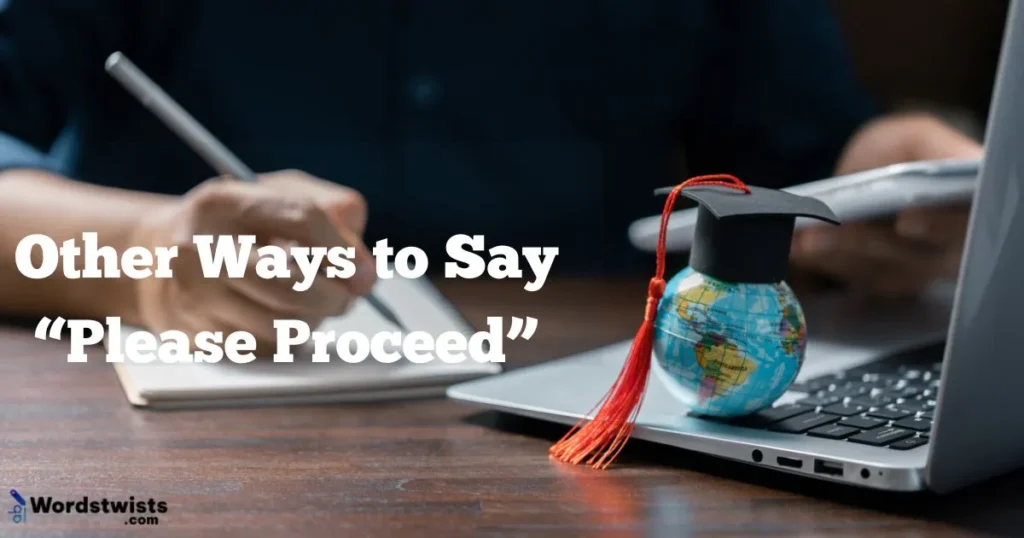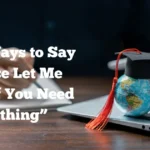Ever feel like you’re using the same old phrase—“please proceed”—over and over again? I’ve been there too. Whether you’re writing an email, leading a meeting, or just having a polite conversation, repeating that same phrase can feel dull and robotic. It’s like trying to add flavor to your words with plain rice—there’s just no spice!
Sometimes we want to sound polite, professional, or even encouraging, but “please proceed” doesn’t always hit the right tone. That’s where a little creativity goes a long way. The good news? There are tons of smarter, sharper, and more human-sounding ways to express the same idea—without sounding stiff or repetitive.
In this post, I’ll walk you through 25 powerful alternatives to “please proceed” that will instantly boost your communication, whether you’re writing, texting, or speaking. Each phrase comes with a quick explanation, practical examples, and a short breakdown of why it works—because using the right words should be simple, not stressful.
👉 Ready to upgrade your vocabulary and add more personality to your conversations? Let’s dive into these better ways to say “please proceed”—you’re going to love how fresh and effective they sound!
Better Ways to Say “Please Proceed”
1. Go ahead
A casual and simple way to let someone know it’s okay to begin or continue. It’s friendly, quick, and works in almost any situation.
Examples:
- “If you’re ready, go ahead with your presentation.”
- “Go ahead and open the file.”
- “You can go ahead and speak now.”
- “Shall we go ahead with the next topic?”
- “Go ahead, no need to wait.”
Why it works:
“Go ahead” is direct but friendly. It fits both casual chats and professional settings without sounding stiff.
2. Feel free to continue
This phrase adds a gentle, polite tone. It makes the other person feel welcome and respected.
Examples:
- “Feel free to continue where you left off.”
- “If you’re comfortable, feel free to continue.”
- “Feel free to continue your story.”
- “No problem at all—feel free to continue.”
- “You were saying something important, feel free to continue.”
Why it works:
It’s polite and encouraging. “Feel free” adds a human touch, making people feel at ease.
3. Carry on
A bit more classic, this one feels confident and even a bit British! It tells someone to keep going with assurance.
Examples:
- “You’re doing great—carry on.”
- “Carry on with the next step, please.”
- “Don’t stop now, carry on!”
- “Carry on and let me know if you need help.”
- “Everything looks good so far—carry on.”
Why it works:
“Carry on” sounds confident and motivating. It keeps the energy flowing while staying polite.
4. Move forward
A powerful option, especially in business or formal settings. It sounds purposeful and clear.
Examples:
- “Let’s move forward with the plan.”
- “We’re ready to move forward now.”
- “Shall we move forward to the next slide?”
- “Let’s move forward and wrap this up.”
- “Move forward once you’ve confirmed.”
Why it works:
It has a professional tone and suggests action. Perfect for meetings, presentations, or emails.
5. Keep going
Simple, supportive, and super conversational. Great for encouraging someone without sounding too formal.
Examples:
- “That’s great—keep going.”
- “You’re on the right track, keep going.”
- “Keep going, you’ve got this.”
- “Keep going till the end.”
- “Nice work—keep going!”
Why it works:
“Keep going” is friendly and motivational. It encourages progress with warmth.
6. Please continue
This one keeps the original tone but feels more genuine and polite when said in a natural way.
Examples:
- “Please continue with your explanation.”
- “You’ve made a strong point—please continue.”
- “Please continue, I’m listening.”
- “Please continue where you left off.”
- “I didn’t mean to interrupt, please continue.”
Why it works:
It’s a polite classic. “Please continue” keeps your message respectful and professional without overcomplicating things.
7. Proceed when ready
Adds a soft layer of respect to the phrase. It gives control to the listener and shows patience.
Examples:
- “Take your time and proceed when ready.”
- “The stage is yours—proceed when ready.”
- “Proceed when ready with the next steps.”
- “We’ll wait; proceed when ready.”
- “No rush. Proceed when ready.”
Why it works:
This phrase respects the listener’s pace and shows that you value their comfort.
8. Whenever you’re set, begin
Sounds relaxed and respectful. It works well when you don’t want to rush someone.
Examples:
- “Take a deep breath. Whenever you’re set, begin.”
- “No pressure—whenever you’re set, begin.”
- “Ready? Whenever you’re set, begin.”
- “Whenever you’re set, begin the demo.”
- “We’re in no hurry—whenever you’re set, begin.”
Why it works:
It offers space. It’s perfect for collaborative environments or situations that need a calm tone.
9. You’re good to go
This is casual and friendly, and it feels reassuring. A great option for informal or semi-formal moments.
Examples:
- “System’s working fine—you’re good to go.”
- “You’ve got all the info—you’re good to go.”
- “Everything’s in place—you’re good to go.”
- “We’ve got the green light—you’re good to go.”
- “You’ve done great so far—you’re good to go.”
Why it works:
“You’re good to go” brings energy and a sense of readiness. It feels like a nudge forward with support.
10. Start when you’re ready
Another phrase that gives the other person space and respect while inviting action.
Examples:
- “No rush—start when you’re ready.”
- “Start when you’re ready, the room is yours.”
- “Everything’s prepared—start when you’re ready.”
- “Take your time, start when you’re ready.”
- “Start when you’re ready, and we’ll follow along.”
Why it works:
It’s warm, respectful, and audience-focused. Great for easing someone into action with kindness.
11. By all means
Short but impactful, this phrase gives enthusiastic permission. It’s confident and clear.
Examples:
- “By all means, go ahead.”
- “If you’re ready, by all means.”
- “Need to share your thoughts? By all means.”
- “By all means, continue with your point.”
- “By all means, begin your demo.”
Why it works:
It adds a sense of openness and encouragement. It’s polite but full of positive energy.
Read More: Other Ways to Say “Strong Skills”
12. Take it away
Very casual and fun! Perfect for presentations, meetings, or handing things over with flair.
Examples:
- “The floor is yours—take it away!”
- “Take it away when you’re ready.”
- “Ready to show us your skills? Take it away.”
- “Now that it’s your turn, take it away.”
- “Take it away and lead the rest of the session.”
Why it works:
It’s energetic and modern. “Take it away” adds style and keeps things light and engaging.
13. Let’s keep it rolling
Smooth and modern, this one works great in group settings where momentum matters.
Examples:
- “That was great—let’s keep it rolling.”
- “No need to pause—let’s keep it rolling.”
- “We’ve got good flow—let’s keep it rolling.”
- “Let’s keep it rolling and move to the next point.”
- “We’re on fire—let’s keep it rolling!”
Why it works:
It keeps up the energy and flow, making your communication feel alive and in motion.
14. All set? Go for it
This one feels casual and encouraging. It checks for readiness while giving a green light.
Examples:
- “All set? Go for it.”
- “If you’re ready, go for it.”
- “All set? Go for it, no need to hold back.”
- “Whenever you feel ready—go for it.”
- “All set? Go for it, the mic’s yours.”
Why it works:
It combines confidence with politeness, making it great for teamwork and collaboration.
15. Go on ahead
More casual and relaxed than “please proceed,” but still gets the job done.
Examples:
- “Go on ahead, I’ll catch up.”
- “You’re ready—go on ahead.”
- “Go on ahead with the next step.”
- “Please go on ahead, no worries.”
- “If you don’t mind, go on ahead.”
Why it works:
It’s a smooth, natural phrase that feels human and real—just like everyday conversation.
16. Jump right in
Lively, welcoming, and encouraging. This one’s perfect when you want someone to feel excited about getting started.
Examples:
- “If you’re ready, jump right in.”
- “No need to wait—jump right in.”
- “We’re eager to hear—jump right in.”
- “Jump right in and share your thoughts.”
- “Ready to start? Jump right in!”
Why it works:
It adds enthusiasm and lowers tension. Perfect for making someone feel like their input is wanted right now.
17. Step right up
Friendly and energetic. Works especially well when giving someone the floor or encouraging participation.
Examples:
- “Step right up and tell us what you’ve got.”
- “Who’s next? Step right up!”
- “Step right up to the mic when you’re ready.”
- “Your turn—step right up.”
- “Feel confident—step right up!”
Why it works:
It’s playful and has confidence-boosting energy. It invites action in a supportive way.
18. Begin whenever you’re ready
Super respectful, gentle, and stress-free. Ideal for interviews, sessions, or thoughtful discussions.
Examples:
- “No rush—begin whenever you’re ready.”
- “We’re all ears—begin whenever you’re ready.”
- “When you’re comfortable, begin whenever you’re ready.”
- “Take your time. Begin whenever you’re ready.”
- “Begin whenever you’re ready, and we’ll follow your lead.”
Why it works:
This phrase gives a sense of comfort and control to the other person. It’s ideal for creating a safe space.
19. You may proceed
Polished and a little more formal. Good for written communication or official contexts.
Examples:
- “You may proceed with the next section.”
- “Once approved, you may proceed.”
- “You may proceed when the light turns green.”
- “All clear—you may proceed.”
- “You may proceed as discussed earlier.”
Why it works:
It’s simple, formal, and authority-friendly. Perfect for legal, academic, or structured business communication.
20. It’s your turn
Clear and conversational. This one works well in teamwork or group conversation.
Examples:
- “All done here—it’s your turn.”
- “It’s your turn to shine.”
- “You’ve got this—it’s your turn.”
- “It’s your turn, go ahead.”
- “No pressure, but it’s your turn!”
Why it works:
This phrase keeps it real. It’s inclusive, friendly, and easy to understand—especially in collaborative settings.
21. Dive in
Short and energetic. Encourages someone to begin with excitement and confidence.
Examples:
- “Ready to dive in?”
- “Don’t hold back—dive in!”
- “Let’s dive in and get started.”
- “You’ve prepared well—dive in.”
- “Take a deep breath and dive in.”
Why it works:
It brings a sense of action and boldness. “Dive in” helps break hesitation and push forward with energy.
22. Continue at your own pace
Gentle and caring. Ideal for relaxed conversations or when you don’t want to rush someone.
Examples:
- “You’re doing fine—continue at your own pace.”
- “No pressure, continue at your own pace.”
- “Continue at your own pace, I’m listening.”
- “Just breathe and continue at your own pace.”
- “We’ve got time—continue at your own pace.”
Why it works:
Perfect for showing empathy and patience. Great in coaching, mentoring, or emotional support contexts.
23. Take the next step
Sounds confident and direct. Suggests that progress is expected and welcomed.
Examples:
- “You’re ready—take the next step.”
- “We’ve reviewed the plan—take the next step.”
- “Now that it’s clear, take the next step.”
- “It’s your move—take the next step.”
- “Go ahead and take the next step forward.”
Why it works:
Action-oriented and powerful. It works well in guiding people through a process or decision.
24. Roll on
Cool and slightly informal. Perfect for conversations that are moving along smoothly.
Examples:
- “Good job so far—let’s roll on.”
- “No reason to stop—roll on.”
- “You’ve got momentum—roll on.”
- “Let’s roll on to the next idea.”
- “Everything’s in motion—roll on.”
Why it works:
“Roll on” keeps things light and dynamic. It adds rhythm to your conversations or presentations.
25. Lead the way
Empowering and positive. Great when giving someone authority or encouraging initiative.
Examples:
- “We trust your judgment—lead the way.”
- “You’re in charge now—lead the way.”
- “All eyes are on you—lead the way.”
- “Go ahead and lead the way, we’re following.”
- “You’re the expert—lead the way!”
Why it works:
It shows confidence, trust, and empowerment. Perfect for making someone feel capable and respected
Conclusion
Using the same phrase over and over again can make your communication feel dry and lifeless. But with these 25 fresh alternatives to “please proceed”, you now have the power to express yourself in ways that are more natural, personal, and engaging.
Whether you’re writing an email, leading a team, giving instructions, or just having a friendly chat, these creative synonyms will help you sound more confident, polite, and human. Words matter—and with the right ones, you can leave a stronger impression.

I’m Leo Knox, the wordplay wizard behind WordsTwists.com where I turn everyday meanings into funny, clever, and creative twists. If you’re tired of saying things the boring way, I’ve got a better (and funnier) one for you!


